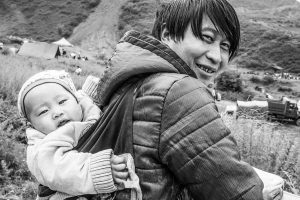

In a world where despite immense diversity, same patterns prevail, one is always looking for a distinctive system, able to stand on its own, oblivious to what is considered “normal”.
Considering the certainty of motherhood, it is remarkable that both patriarchy and patrilineality has been the predominating model for the vast majority of societies.

In Tierra del Fuego there is a legend among the Yagan indigenous population depicting women holding the initial power over men. Only women practiced activities normally associated with the male role. However, the men grew tired of being exploited by the women and one day- killed them all. Only newborn girls were left alive; as they matured, the men imposed the belief that their only purpose in life was to serve them. They believed it, and so did their daughters, and the daughters of their daughters.

Inequality leads to rebellion. The “equivalent” of something in a gender may not necessarily mean the same thing in the other. This is the case of “matriarchy” versus “patriarchy”. All matriarchal societies that have existed, and the few that persist today, do not base absolute power on the woman, oppressing the man, as alleged by this legend of the indigenous of Tierra del Fuego (which justifies the later imposition of men). Instead, the power of the woman is still limited to the house and clan, while man is still bequeathed with politics and business. Although each has their own scope, decisions are based on the mutual dialogue between men and women.

In Southern China there is a matrilineal community living on the shores of the Lugu, an alpine lake located just under 2,700 meters altitude, between the provinces of Yunnan and Sichuan. They are the Mosuo.
According to documents from the Han dynasty, their ancestors were tribes who migrated from Tibet in the fourth century. Being highland dwellers, they decided to stay at altitude, close to their gods. Until recently, access to the lake was a hard and dangerous endeavour, which helped its inhabitants to keep their traditions relatively intact.

At first, the Mosuo had a feudal system, with nobility that controlled the rural population. One theory states that the nobility was governed by a patriarchal system; in order not to have their authority threatened, they imposed matrilineality on the peasantry. Theory or not- patriarchy, nobility and the feudal system have fallen; the current social organization among the Mosuo is matrilineality.
The family structure of the Mosuo is organized around clans that are named after the retired matriarch or mother of the clan. It’s this first generation of the house, aged between 60 and 80 years, who dedicate themselves to the worship of their ancestors. The matriarch, dabu, belongs to the second generation and is usually aged between 40 and 60, although they may be younger. Elected by the clan, they are in charge of organizing the work of the members of the family, managing the house and the family possessions, and taking charge of the social affairs of the clan. With no personal privileges and an immense weight on her shoulders, she is the most competent woman of the family. The brother of the matriarch is elected as the clan representative outside the house, dealing with external affairs and communication with neighbours. The third and fourth generations are the young adults and children. Newborns are considered to be the reincarnations of their ancestors and are taken care with dedication and respect: in Mosuo society those who are vulnerable, are not.

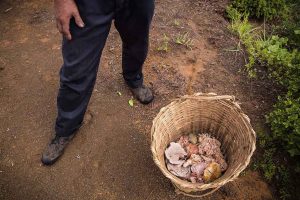
Mosuo families have a much stronger internal cohesion than those of patrilineal traditions. The sense of nurturing and protection arises naturally, regardless of age or gender; the most defenceless, old or young, are wrapped in an expression of selfless love and care. This family cohesion naturally exceeds the walls of the house and friends are valued as part of the family. There are no rivalries and groups of men and women always seek an occasion to meet and share each other’s company. The women talk and sing while they work and the men smoke and talk over a game of cards or mahjong.
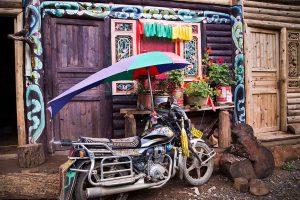
The houses are rectangular with rooms that overlook a courtyard where children and domestic animals run freely, while the busiest people in the house (mostly the matriarch and the women) carry on with their daily chores. The most important room in the house is the living room; at its centre a brazier burns with everlasting fire. This symbolizes the heart of the house; a heart cared for by the eldest of the clan. The doorframe is smaller than the others with a double function: this forces visitors to lower their head in sign of respect as they walk in, and (to some extent) the intrusion of animals. A tall stranger unaccustomed to this may, unintentionally- hit forehead with knee. The living room is used as a kitchen as well as an altar to the gods and ancestors. Here, ceremonies are held and visitors are received. It also functions as the bedroom for the whole family. The adult women each own a private room where they receive their axia, their lovers.
In the Mosuo society people practice the zouhun, the “walking marriage”, which means freedom to choose a lover. It should not be considered promiscuity but serial monogamy, since especially from middle age, Mosuo women tend to seek long-term relationships. In the Mosuo language a lover is called azhu sese, meaning “the friend who comes and goes.” Courtship takes place during daily activities or at dances, where women remain delicate and allow the men to seduce them. Matriarch authority is left at home, in order not to tarnish the virility of the suitor.
Unique in the world, this type of matchmaking has two versions. One is secret and usually brief: a man sneaks in and out of the woman’s bedroom with nocturnality and premeditation, while the rest of the inhabitants of the house is asleep. The other is open and stable, where the man can be seen by the family and even attend some ceremonies of the clan. This usually happens once the lovers have offspring and they’ve received the matriarch’s approval. In any case, he’s titled “father of the child” rather than “partner”.

Lack of marriage ensures wealth is equally distributed and administered by the matriarch. Traditionally, official marriage was seen as a threat to a family’s integrity. However, today Han influence has standardized official marriages, especially among younger generations.
During the Cultural Revolution, the Communists saw this habit of walking marriage as an aberration. In the beginning they offered men land to cultivate if they formed their own family outside the mother’s home, but given the lack of interest, they decided to impose marriage. It was common to see three generations of the same family passing through the vicarage at the same time. But in reality this imposition was a blunder for the Mosuo, since it destroyed the family unit they had once been used to. People felt a discomfort that came with pressure, and tensions soon sparked between men and women. Like everywhere else in China, reality is imbued with a contradiction that is actually a dualism; while they tried to abolish arranged marriages in the rest of China, they arranged them within the Mosuo.
According to Mathieu, love is generally sacrificed for a “good” marriage, or marriage is sacrificed for sexual freedom. The Mosuo however, have everything: sexual freedom, romantic love, financial security, and continuity in the bloodline. Relations between lovers are simplified, as they are based only on attraction and love. Jealousy, though it may exist, is not something to be proud of, so they tend to hide it in public. Violence is not welcomed in this community either. For them, love is to yield to desires, a noble sentiment that should not be denatured with manifestations of jealousy or violence.

Both sons and daughters are valid, although there is general pride in the birth of a girl, as they are more likely to bring offspring to the family and be a matriarch in the future. Families who have only sons and practice zouhun, will need offspring and seek to adopt one of the lovers of the men as dabu. After a trial period, she can be accepted as part of the family. However, in these cases the patrilineal pattern coexists with the matrilineal- until they reach the needed number of female members to bring the matrilineal structure back into balance. On the other hand- if they only have female offspring they will attempt to integrate men into the family, whether by marriage or adoption.
But although genealogy is matrilineal, the status of men and women is the same. The matriarch of the house manages property, though it belongs to all family members. Since there are no divisions and they all work on it, it grows while life goes on, with no new generation forced to start from scratch. If there were too many in a single home, a daughter separates from the mother, who will help her build a new house, offering at times; land, animals or tools.
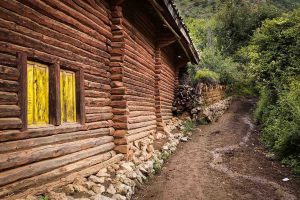
The matriarch is, above all, a link. All members view their relationship based on the mother who is respected and honoured. This respect extends to all women in general, for their potential to be mothers. For men- to be in the hands of woman is to be in better hands. Man has power within the mother’s family, he is the father figure of his nieces and nephews, grandfather of the children of his nieces … The mother’s brothers are uncles and fathers, the brothers of the grandmother are grandparents, mother’s sisters are the same as the mother, the children of maternal aunts are brothers. This creates a great network one can rely on to overcome any obstacle. If there was a problem at public level, the village chief, usually a man, is responsible to solve it mediating between neighbours before things get worse.
Mosuo men work in commerce and sometimes at the most arduous household chores when they are at home. They were formerly in charge of the trade caravans commuting to different places around China. This created a habit, placing women responsible for the majority of work both in the house and at the field, while men tend to relax, smoking in the sun, playing cards with their mates at the courtyard. Sometimes even a simple task (such as fetching firewood) can take a dragging by the heels from the matriarch.
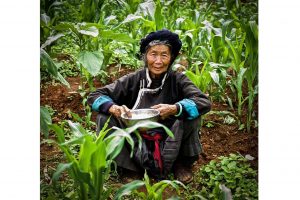
The growth of a domestic tourism curious of the originality of itself, represented by ethnic minorities in China, especially with the combination of its scenic beauty and peculiar customs, projects an improvement in communications. Better roads and airports will bring progress to the living standards of the locals, and artificiality to their customs. This implies a threat to the friendly life of the Mosuo and the strength of the family institution, fuelled by its disdain for violence and the accumulation of money.

The other institution in Mosuo society is religion. As the peaceful coexistence of patrilineal and matrilineal structures among them, there are several religions that coexist. Each represents an equal importance at rituals: two branches of Tibetan Buddhism, Gelugpa (the best known and most widespread) and Bön, a former Tibetan indigenous religion previous to Buddhism, with animistic elements and more macabre customs. They also have their own ethnic religion, officiated by the daba, a shaman who maintains the historical tradition of the Mosuo and officiates at rituals; such as naming the newborn, the coming of age, funerals, etc. This religion is very close to the Dongba, the religion of the Naxi, but more primitive. Echoing their animist tradition, the Mosuo also worship elements of nature, great creator of all, where the large represents the feminine and small the masculine. They have two goddesses in the region who protect them, the mountain goddess and goddess of love, Gemu, and the mother goddess, Shinami, which is the lake.
The most important stages of life for a Mosuo are three: birth, coming of age, and death. As they are unaware of the first or the last, coming of age is the most significant. It begins at twelve years of age and from this ceremony on the child can put on adult ethnic costumes for events and ceremonies. The ceremony is held in the living room of the house and family members, close friends and even the father of the child may take part in it. The matriarch officiates, putting a bag of rice on the floor and a zhubiaorou; a pig from which they removed the entrails and bones, stuffing it with onions, garlic, ginger, salt and spices before sewing it close and letting it sit (sometimes up to ten years) in a cool dry place, amazingly ignored by rats. The young protagonist stands on them bare footed, looking for an adult life in prosperity that this gesture hopefully predicts. Each guest dresses the child with one of the elements of the traditional costume that she has made, sized slightly bigger to last longer. In the girl’s case, a white skirt which challenges the dust of the road comes with a traditional belt (at times used to tuck in the excess of fabric) as well as a headdress made of yak wool and silk, that finishes in a long tail, rivalling for attention with the braid it dangles next to. Once the child leaves the parapet of prosperity, he or she is on the path to adulthood and the assumption of responsibilities.
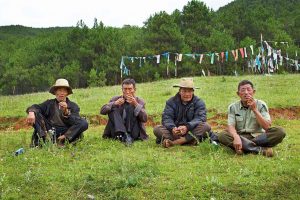

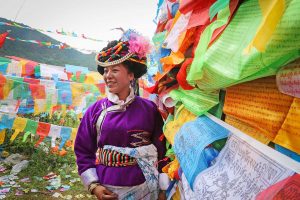
Funerals are held for three days; when possible the family will invite Buddhist monks to recite scriptures, as well as a daba, who, chanting as if sending them off in a lullaby, shows the deceased the way to the ancestors’ dwelling. During the three days, the entire community is invited to dine twice daily; in such a bustle, women of the family are so consumed with hosting, that often only mourn the dead when the ceremony requires it. Wailing and crying has a limit, as any excess would cause heavy rain on the way to the realm of the ancestors.
During the ceremony, elements that belonged to the deceased are arranged on an altar in the living room. The body is set, curled up in a cubbyhole built into the wall, designed specifically for this purpose. The gap can be seen perfectly defined on the living room wall, however, it’s only accessible from the back. After the three days, the body is cremated and the ashes are placed into the common grave of the clan, following the order of their seats around the hearth fire; the women to the right, the men to the left, the older generations above, the most recent at the bottom.
Matriarchal societies focus on the role of the mother, not necessarily being tied to adult women, but exercised by any person who offers a child or infant the care they need to grow- even for limited time and space. This sense of nurturing is spread throughout the community and exercised by all its members, regardless of age or gender. Everyone is valued; they learn it at an early age and apply this belief in all their relationships throughout life. This, for me, is the essence of a matriarchal society, a place where we are all mothers.
